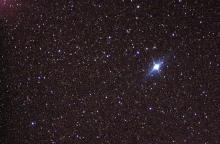Listen to today's episode of StarDate on the web the same day it airs in high-quality streaming audio without any extra ads or announcements. Choose a $8 one-month pass, or listen every day for a year for just $30.
You are here
Bright Beacon
The North Star, Polaris, has served as a beacon for centuries. Its constant position in the night sky allows navigators to plot their latitude north of the equator.
For truly long-range travel, though, the beacon of choice is Canopus, the second-brightest star in the night sky. If you live south of about Dallas, it’s in view on winter nights, well below Sirius, the night sky’s brightest star. Right now, it’s due south in early evening, just above the horizon.
Considering its heritage, perhaps it’s not surprising that Canopus is associated with navigation. It’s the brightest star of the ancient constellation Argo Navis — the ship that carried Jason and the Argonauts. And the name “Canopus” may come from the pilot of another mythological ship, which rescued Helen of Troy.
The star was a beacon to the sailors of Polynesia, among others, who used its light to guide them from island to island.
In modern times, Canopus has guided spacecraft to the Moon and other planets. It’s bright and it’s far away from the Sun’s path across the sky, so a craft can use Canopus and the Sun to triangulate its position.
Canopus has even played a role in navigating to the stars. It was home to the planet Arrakis in the novel “Dune.” The planet contained the only supply of “spice.” Consuming a lot of it gave the user the ability to navigate between the stars. So stellar navigation was made possible by Canopus — a star that helps modern-day navigators sail to other worlds.
Script by Damond Benningfield




